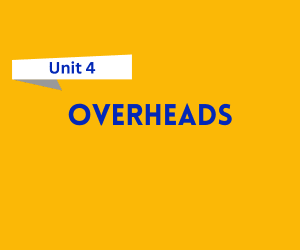In addition to direct costs like materials and labour, every business incurs various indirect expenses necessary for operations. These indirect expenses, known as overheads, must be properly accounted for to determine the true cost of production. This unit focuses on the classification, allocation, absorption, and accounting of overheads in cost accounting.

Download UNIT 4 – Overheads and Accounting Notes
Get simplified revision notes for this unit:
Download Unit 4 Notes PDF
What Are Overheads?
Overheads refer to all indirect costs that cannot be directly traced to a specific product, job, or department. These include expenses such as rent, electricity, depreciation, salaries of administrative staff, etc.
Overheads are essential for running a business but must be managed carefully to maintain cost efficiency.
Classification of Overheads
Overheads can be classified based on different criteria:
By Function:
Production Overheads: Related to manufacturing (e.g., factory rent, machine maintenance).
Administration Overheads: Related to office and managerial functions (e.g., office salaries, stationery).
Selling and Distribution Overheads: Related to marketing and delivering products (e.g., advertising, delivery charges).
By Element:
Indirect Materials
Indirect Labour
Indirect Expenses
By Behavior:
Fixed Overheads: Do not change with output (e.g., factory rent).
Variable Overheads: Vary directly with production (e.g., power usage).
Semi-variable Overheads: Partially fixed and partially variable (e.g., telephone bills).
Allocation and Apportionment of Overheads
Before overheads can be charged to products or jobs, they must be allocated and apportioned:
Allocation is the process of assigning whole overheads directly to a cost center (e.g., rent for a specific department).
Apportionment involves dividing overheads between different departments or cost centers based on a fair basis (e.g., floor area, number of employees).
These processes ensure that each unit or department bears a fair share of the indirect costs.
Absorption of Overheads
Once overheads are allocated and apportioned, they are absorbed into the cost of products using various methods. The main absorption methods are:
Actual Rate: Based on actual overheads and actual activity level.
Predetermined Rate: Estimated in advance based on budgeted overheads and budgeted output.
Blanket Rate: A single rate for the whole factory.
Machine Hour Rate: Based on machine usage time.
Choosing the right absorption method ensures accurate cost estimation and helps in pricing and decision-making.
Over-absorption and Under-absorption
Sometimes the overheads absorbed may not match the actual overheads incurred:
Over-absorption: When absorbed overheads exceed actual overheads.
Under-absorption: When absorbed overheads are less than actual overheads.
These differences may occur due to inaccurate estimates or unexpected changes in output. They are usually adjusted by transferring to a cost variance account or adjusting in the cost of sales.
Administration, Selling, and Distribution Overheads
Administration Overheads cover general management costs such as office rent, administrative salaries, and legal fees.
Selling Overheads include advertising, sales staff salaries, and promotion expenses.
Distribution Overheads are related to storage, packaging, and transportation of finished goods.
Proper classification and control of these overheads help in budgeting and increasing overall business efficiency.
